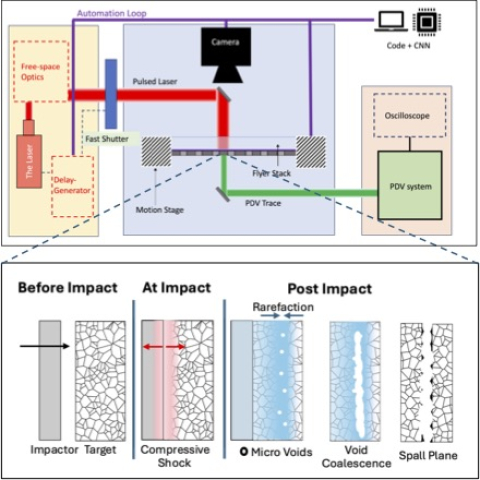Active Research Projects

This project provides major instrumentation for the Johns Hopkins Hypervelocity Facility for Impact Research Experiments (HyFIRE) to enable us to perform state of the art plate impact experiments on elastomers at very high impact velocities (1-3 km/s) relevant to critical defense applications.
Collaborators: Matt Shanaman, Brian Rapids (APL)
Office of Naval Research
Project Status: Active
Grant Number: DURIP

Concrete is subjected to impact and blast loads in a variety of applications. Working with industry collaborators, we develop and implement data-driven constitutive models for concrete under these extreme conditions.
Collaborators: The MSEE URA; Prof. Ryan Hurley, Prof. Todd Hufnagel; Karagozian & Case
Defense Threat Reduction Agency
Project Status: Active
Grant Number: MSEE Sprint

Rocks and geomaterials are subjected to impact and blast loads in a variety of applications. We develop and implement multi-mechanism constitutive models for such materials that can describe their behavior under these extreme conditions.
Collaborators: The MSEE URA; Prof. Ryan Hurley, Prof. Todd Hufnagel, and Prof. Michael Shields
Defense Threat Reduction Agency
Project Status: Active
Grant Number: MSEE URA

The AI-driven design of materials for demanding applications requires the availability of high-throughput experimental methods to obtain data in the relevant extreme conditions. Here we develop automated laser shock experiments to rapidly explore the materials design space, working in collaboration with synthesis and processing, characterization, modeling, and robotics groups.
Collaborators: None specified.
DEVCOM Army Research Laboratory
Project Status: Active
Grant Number: AMDEE

The AI-driven design of materials for demanding applications requires the availability of high-throughput experimental methods to obtain data in the relevant extreme conditions. Here we use automated laser shock experiments to understand the behavior of ceramics under high strain rates and high temperatures. This project involves major collaborations under the HT-MAX and HTMDEC programs.
Collaborators: The HT-MAX and HTMDEC teams; Prof. Wei Chen and Prof. Ian McCue at Northwestern University; Prof. Chris Hansen at UMass-Lowell
DEVCOM Army Research Laboratory
Project Status: Active
Grant Number: HT-MAX
Motivated by the DART mission, we study cratering processes, ejecta formation, and momentum enhancement after hypervelocity impact into rubble pile asteroids.
Collaborators: Dr. Angela Stickle and Dr. Ron Ballouz at the Johns Hopkins Applied Physics Laboratory
National Aeronautics and Space Administration
Project Status: Active
Grant Number: NNH23ZDA001N-FINESST

We develop methods to use data from magnetic resonance elastography (MRE) and tagged magnetic resonance imaging (MRI) to build and assess computational models of the living human brain, so as to better predict actual patterns of brain deformation. We parameterize and assess the models using experimental data, emphasizing the modes and natural frequencies of brain oscillation and the response of the brain to frequencies in skull motion. We use two model types: (i) population-average models for each age/gender group; (ii) subject-specific models. We focus on nonlinear, hyper-viscoelastic models intended for large deformations. This project provides the capability to accurately simulate brain deformation and to interpret model predictions, ultimately enabling end-users to relate mechanics to pathology.
Collaborators: Prof. Philip Bayly and Dr. Ruth Okamoto at Washington University in St. Louis; Prof. Curtis Johnson at the University of Delaware; Dr. Dzung Pham at the Henry Jackson Foundation; Dr. John Butman at the NIH Clinical Center
NIH National Institute for Neurological Disorders and Stroke
Project Status: Active
Grant Number: U01 NS112120.

Amorphous polymers like polycarbonate are heavily used in protection applications that involve impact threats. This project focuses on understanding the fundamental mechanisms of failure in such polymers at nanosecond to microsecond timescales.
Collaborators: Dr. Saryu Fensin, Dr. Dana Dattelbaum, and Dr. Gary Simpson at Los Alamos National Laboratory; Prof. Thomas O'Connor at Carnegie-Mellon University
Project Status: Active
Grant Number: Multiple

Major impact events can transport significant amounts of material between solar system bodies (for example, from Mars to Earth). This project brings together mechanics and astrobiology to determine the limits of life under the dynamic conditions relevant to major impact events in the solar system.
Collaborators: Jocelyne DiRuggiero (Biology)
National Aeronautics and Space Administration
Project Status: Active
Grant Number: 80NSSC20K0667